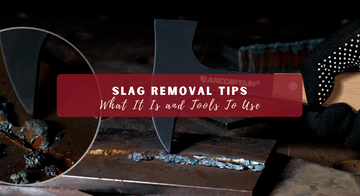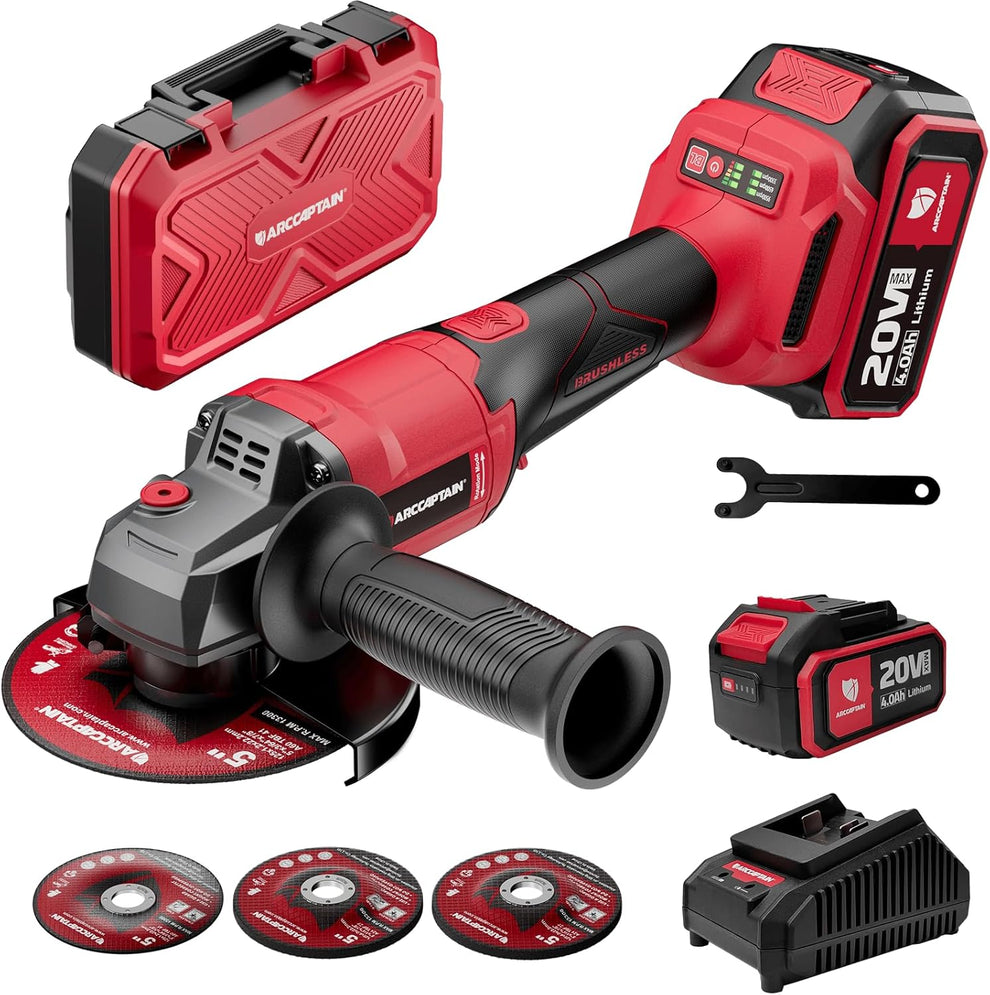
Slag removal is a crucial step in the welding process that ensures your welds are clean, strong, and free from defects. Every welder knows the frustration of chipping away at stubborn slag after finishing a bead.
Slag is the hard, glassy layer that forms over welds in processes like stick and flux-core welding. If not removed, it can trap defects inside your weld, cause failed inspections, or make multi-pass welding impossible.
In this guide, you’ll learn what slag is, why removing it matters, the best tools to use, step-by-step cleanup workflows, prevention tips, and safety checklists. By the end, you’ll know exactly how to handle slag so your welds stay clean and strong.
Quick Slag Removal Takeaways:
- Remove slag as soon as possible after welding to maintain clean welds.
- Use an appropriate mix of slag or chipping hammer, wire brush, angle grinder, or needle scaler.
- Always wear safety gear like gloves, eye protection, and face shields while removing slag.
- Match your tools with the weld size, accessibility, and metal type for best results.
- Keep your tools maintained for easier and safer slag removal.
You May Want to Shop 🛒

ARCCAPTAIN Welding Chipping Hammer
- Tough Alloy Steel Head: Rated HRC50–55 for durability and +30% greater impact resistance.
- Comfort Grip Handle: Solid wood with ergonomic, anti-slip design that reduces hand fatigue during long use.
- Protective Anti-Rust Coating: Phosphating finish prevents corrosion and wear for long-lasting performance.
- Lightweight Control: 14oz design offers excellent balance, precision, and strike accuracy.
- Dual-Head Versatility: Features a sharp point and 1.18" chisel end—ideal for woodworking, metalwork, and detail tasks.
- Built for Pros and DIYers: Reliable, efficient, and made to handle demanding jobs safely.
What Is Slag and Why Remove It?
Slag is a byproduct of certain welding processes, such as Shielded Metal Arc Welding (SMAW) or Flux-Cored Arc Welding (FCAW).
It is made of flux material that melts and floats on the metal, protecting the weld pool from oxidation during the cooling process.
However, after welding, slag forms a solid layer that must be removed because:
- It can trap impurities or moisture, causing weld defects or corrosion.
- It hides the weld bead, making inspection and finishing difficult.
- Leftover slag can interfere with subsequent passes or additional welding.
Removing slag helps ensure a clean, strong, and aesthetically pleasing weld.
👉 Also Read: Lack of Fusion in Welding: Causes and Solutions
Slag Removal Tips
Slag removal is easier when you use the right tools and work in short, steady strokes to avoid damaging the surface.
Always wear safety gear and keep your workspace clean to achieve smooth, professional results every time.
1. Remove Slag Promptly
The best time to remove slag is shortly after the weld has cooled but is still warm. This makes slag easier to chip off with less effort.
2. Choose the Right Tool
Different weld sizes and shapes require different tools. Large, thick welds might need heavy-duty grinders or needle scalers, whereas small, thin welds can be cleaned with a chipping hammer and a wire brush.
3. Be Gentle to Avoid Damaging the Weld
Aggressive or careless slag removal can chip or gouge your weld bead. Use moderate force and avoid over-grinding.
4. Use Personal Protective Equipment (PPE)
Always protect your hands with gloves and your eyes with safety glasses or a shielding helmet. Sparks and flying slag fragments can cause injury.
5. Maintain Your Tools
Keep wire brushes clean and replace worn, chipping hammer heads for the best performance and safety.
👉 Also Read: Welding Machine Troubleshooting: Common Problems and Solutions
Best Tools for Removing Slag Effectively

The best tools for removing slag are sturdy chipping hammers, wire brushes, and slag hammers built for weld cleanup.
Using high-quality, well-balanced tools helps you clear residue faster and maintain smooth, strong welds.
1. Slag Hammer / Chipping Hammer
- Classic slag removal tool with a flat chisel on one side and a pointed pick on the other.
- Use the flat side to strike and chip away slag chunks.
- The pointed end helps scrape out tight corners or small slag pockets.
- Lightweight and affordable.
2. Wire Brush
- Comes in hand-held and power versions.
- Used to scrub off loose slag and clean the surface.
- Brass, stainless steel, or carbon steel bristles, depending on material.
- Power brushes increase speed but require care to avoid surface damage.
3. Angle Grinder with Flap Disc
- Effective for removing stubborn slag and smoothing welds.
- Choose the correct grit for the finish required – coarse for heavy slag, fine for smoothing.
- Use with caution to prevent gouging; gently angle the disc.
You May Want to Shop 🛒

20V Brushless Angle Grinder – Pro Performance
- High-Performance Brushless Motor: Delivers up to 9500 RPM with consistent power and longer service life for heavy-duty cutting, grinding, and polishing.
- Fast-Charging Battery System: Includes 2×4000mAh lithium batteries (10C discharge) and 20V/2A quick charger, compatible with Makita interfaces.
- 3-Speed Precision Control: Choose from 3300, 6500, or 9500 RPM to match any metal cutting, surface prep, or polishing job.
- Wheel Size Flexibility: Fits standard 4-1/2" and 5" discs for versatile use on any project.
- Dual-Side Adjustable Handle: Ergonomic design suited for left or right-handed operation, reducing fatigue during long tasks.
4. Needle Scaler
- Pneumatic or electric hammering tool with multiple needles.
- Vibrates rapidly to break slag off hard-to-clean surfaces or large joints.
- Ideal for industrial or high-volume slag removal.
5. Slag Removal Pliers
- For precise removal in hard-to-reach spots.
- Squeeze-type handles make picking up broken slag chunks easy.
6. Portable Air Hammer
- A powerful pneumatic tool often used in fabrication shops.
- Can remove large quantities of slag fast.
- Requires an air compressor and safety training to operate.
👉 Also Read: Welding Gouging: Top 4 Most Popular Gouging Processes Explained
Safety Tips When Removing Slag

- Wear heat-resistant gloves to protect hands from hot slag and sharp fragments.
- Use safety goggles or face shields to protect your eyes from flying debris.
- Work in a well-ventilated area to avoid inhaling dust.
- Keep bystanders away from areas where slag is being removed.
- Inspect tools regularly for wear or damage.
Final Thoughts
Slag removal is a key step that improves both the strength and appearance of your welds.
With the right techniques and tools, such as chipping hammers, wire brushes, grinders, and needle scalers, you can clear slag quickly and safely.
Always wear proper safety gear and maintain your tools to work efficiently.
Take control of your welding quality today by mastering slag removal. And if you’re looking to upgrade your welding tools and consumables, check out these trusted collections from Arccaptain:
Clean welds mean stronger welds. Happy welding and stay safe!
FAQs About Slag Removal
How soon after welding should I remove slag?
Wait until the weld cools to a safe touch and the slag turns dull and brittle. This is usually a minute or two for small beads, longer for thick plate. Removing slag while it is still hot can smear it into the bead and make cleanup harder. Always wear eye and hand protection before you start.
What is the best tool to remove slag?
A chipping hammer and a stiff wire brush are the go-to tools for most welds. For heavy or stubborn slag, a needle scaler or an angle grinder with a flap disc works faster. Choose the lightest tool that gets the job done so you do not damage the bead. Keep brushes and grinder discs in good condition for clean results.
How do you remove slag from welding?
Hold the chipping hammer at a shallow angle and tap along the toe of the bead to lift the slag. Follow with a wire brush to sweep away loose pieces and reveal the weld surface. For thick layers, use short, controlled grinder passes and avoid grinding into the bead. Inspect the weld and repeat until the metal is clean and bright.
How do you remove slag from molten metal?
You do not remove slag while it is fully molten on a weld. Let the puddle solidify first, then chip and brush it off. In foundry or melting work, operators skim floating slag from the melt using a slag rake or spoon once it forms on top. Always follow heat and PPE safety rules due to splash and fumes.
What hammer is used to remove slag?
A welding chipping hammer is designed for this job. It usually has a pointed end for tight spots and a chisel end for lifting larger flakes. The spring or cushioned handle helps absorb shock during tapping. Keep the edges sharp so it pops slag cleanly without extra force.
Why is my slag so hard to remove?
Slag sticks when the weld parameters are off, like too little heat, poor travel speed, or the wrong rod angle. Dirty base metal and moisture in electrodes can also make slag fuse to the bead. Multi-pass welds without proper cleaning between passes trap slag and make it stubborn. Fix by cleaning the joint, storing rods dry, and dialing in amperage, angle, and travel speed.
